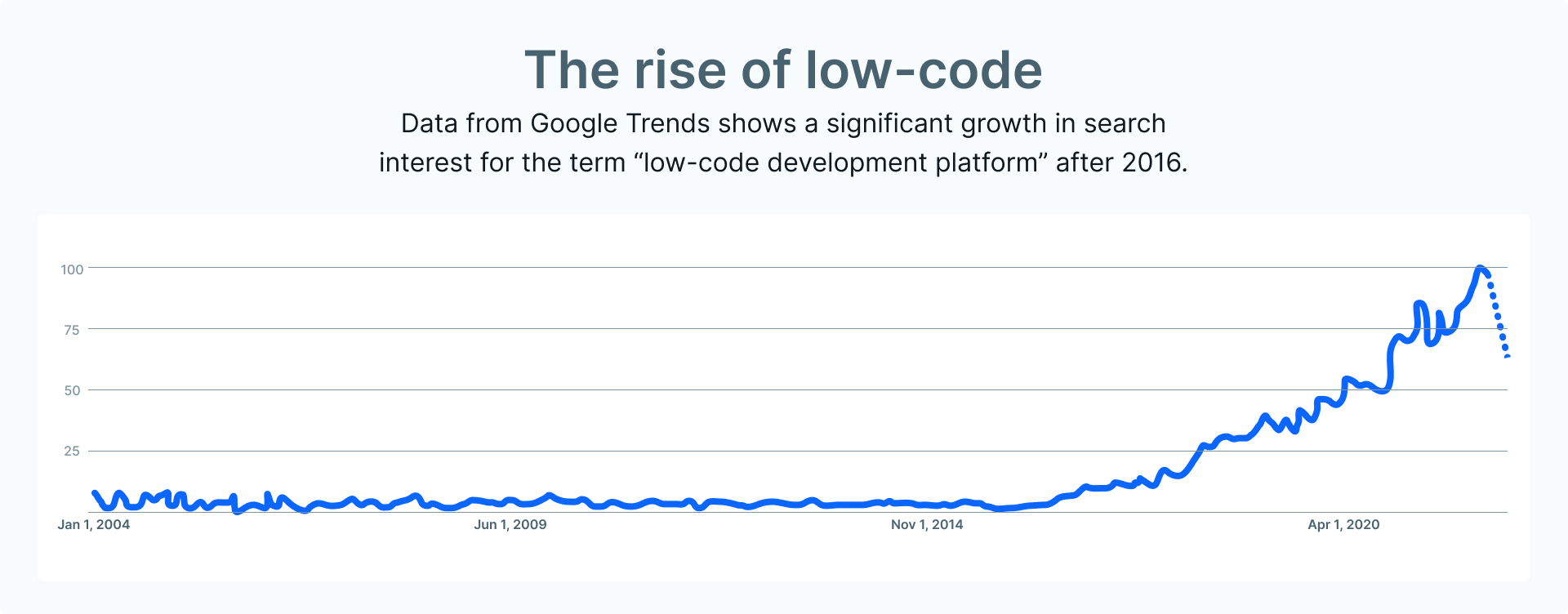
Low-code software has officially gone mainstream. A quick Google search for “low-code” returns over 2 billion search results on what low-code software is and isn’t.
Don’t get lost in the noise. Whether you’re new to low-code or in the market for a solution that works for your team or business, here are six myths (and truths) to set the record straight on low-code.
Myth #1: Low-code is just a trend
Truth: Low-code isn’t new, it’s not a trend, and it’s not going anywhere any time soon.
While it may seem like the rise of low-code happened overnight, it’s been a decades-long journey. Below is a timeline of how this visual approach to development became the market it is today.
1970s – 1980s: Fourth-generation language (4GL) builds upon previous language generations and paved the way for computer programming languages that are more human-friendly. In other words, something that’s more accessible to people without formal programming training (a foreshadowing of the term “citizen developer”).
4GL is the foundation of low-code platforms that enable non-technical users to deploy rapid solutions, or applications, in a short amount of time and without the need of a developer.
In his book “Applications Development Without Programmers,” James Martin became one of the first to promote 4GL as a solution to a problem that is all too familiar today: a shortage in knowledge workers.
4GL supports database management, report generation, graphical user interface development, web development, and mathematical optimization – common features of many low-code platforms on the market today.
No-code automation empowers business teams without overpowering IT. Read the report No-Code Automation: Good for Business, Great for IT
The number of programmers available per computer is shrinking so fast that most computers in the future must be put to work at least in part without programmers.
– James Martin, “Applications Development Without Programmers”
2014 – 2016: Industry analysts like Gartner and Forrester begin to promote “low-code platforms.” In 2016, Forrester released a report touting the “fertile terrain of low-code application platforms,” predicting a multi-billion market size by 2020.

(Click here to enlarge image)
2019 – present: The COVID-19 pandemic pushes the low-code market into hypergrowth. In 2018, the low-code development market was valued at $7.87 billion. Today, the market is expected to reach $47.31 billion by 2025. Gartner also estimates that by 2025, 70% of new applications developed by enterprises will use low-code or no-code technologies.
Low-code features and benefits like low-code automation and citizen development give non-technical business users the power to build and deploy solutions quickly and adapt to business/industry changes in real-time.
Low-code has now also established itself as a resource for understaffed IT teams and a solution to overflowing IT backlogs. (More on that later.)
Myth #2: Low-code increases security risks
Truth: Low-code software can help reduce risk.
Many low-code platforms have security features baked in and improve visibility, making it easier for IT to enforce security. Features like low-code automation also help standardize processes, create process consistency, and reduce errors – all sources of risk that can be solved with a BPA solution.
Additional features, like permissioned-user access, also let teams decide who gets access to what, allowing safe collaboration between internal and external stakeholders.
For ease of mind, here are some compliance credentials, certificates, and capabilities to consider as you shop for a low-code platform:
- ISO 27001
- GDPR
- LGPD
- SOC2
- SSO
- 2FA
- In-platform data encryption
Myth #3: Low-code is shadow IT
Truth: Low-code provides business users the benefits of shadow IT, like agility and flexibility, without compromising the IT team’s need for control, visibility, and security.
By definition, shadow IT is tools or software solutions managed outside of the IT department, usually without their knowledge or control. Usually, shadow IT is deployed by teams that aren’t getting the solutions that they need when they need them. This makes governance, process consistency, and process standardization difficult to manage and opens companies to potential security risks.
Low-code is shadow IT flipped upside down. Low-code solutions are IT-sanctioned and give IT total visibility, making it a great solution for business areas needing agility and IT teams needing control and oversight.
Myth #4: Low-code replaces IT and dev teams
Truth: Low-code balances the areas of ownership between IT and business areas by placing them in co-creator roles.
For business areas, low-code platforms empower them to own and manage the processes that they live and work with every day. The visual drag-and-drop interface makes it easy for business areas to securely deploy solutions at their pace and required level of detail.
For IT teams, low-code resolves the backlog burden. By reducing the company’s dependency on IT to implement every single process improvement (manually and repetitively across various business areas), IT teams are able to focus on overseeing their areas of expertise, like governance and compliance, identity management, legacy system integrations, and digital transformation initiatives.
Low-code platforms place IT and business teams in co-creator roles, allowing them to become more strategic and efficient partners.
Myth #5: Low-code software only works for simple processes and small teams
Truth: Low-code automation platforms’ customizable features are built to handle processes – both simple and complex – that depend on input from various teams.
Low-code empowers business users with capabilities like integrations via APIs for a seamless operation and user experience, automations to streamline communication and improve collaboration, and a visual drag-and-drop interface that lets non-technical business users develop and deploy solutions for long-tail process problems and improvements to existing processes.
Below is how Pipefy’s low-code automation platform helped teams – both large and small – solve their process management problems by building a low-code BPM strategy.
| Company | After implementing a low-code platform |
|---|---|
| Coplacana | – Standardized disparate processes across 30 business branches – Teams using Pipefy: Credit and Register, Finance, IT, Auditing, Sales, Human Resources – Processes in Pipefy: New member registration, Credit Risk and Limit Analysis, Service Desk, IT Projects and Demand Management, Auditing and Internal Controllership, Capital Expenditure (CAPEX), Organizational Human Development |
| CNH | – Integrated 15+ tools and systems to create a seamless user experience. – Teams using Pipfy: People Ops – Processes in Pipefy: 100 active processes, including Recruiting, Employee Onboarding, Hiring, Reimbursement, HR Requests, Payroll, and a COVID-19 Health Check |
| DASA | – Increased team’s capacity to resolve supply chain tickets from an average of 236 tickets per month to 931, per employee – Consolidated 20 inbound SLA inboxes into a single workflow – Teams using Pipefy: Supply Chain, Finance, Legal, and Governance – Processes in Pipefy: Supply chain management, Goods and Product Registration, Purchasing, Invoice posting, Logistics planning |
Increased ROI. Strategic decision making. Faster time to value. Better process management with automation. Find out how customers gained control of their operations with low-code automation.
Myth #6: Low-code software’s only selling point is being low-code
Truth: Low-code is the key that unlocks a full spectrum of process management capabilities.
While being low-code is a major selling point for companies seeking a cost-effective way to simplify complexity, the real gift of low-code software is all the other benefits baked in. Below is an example of 10 essential features to look for:

Fact: Low-code is a valuable business process approach that delivers powerful results
While there’s a never-ending inventory of what low-code is and isn’t, the truth is this:
- Low-code’s not a trend and it’s only going to increase in use as teams continue to become more digital.
- Low-code empowers those who understand and manage processes with the power to develop and deploy the solutions that they need to make those processes work.
- Low-code automation software frees IT teams of their backlog burden, allowing them to focus on becoming better strategic partners.
- Low-code can be the backbone of innovation and digital transformation.
- Low-code software is an IT-approved solution for teams looking for better alignment between departments and among the components of the existing tech stack.






